第二章 结构词汇学 (2)
- 格式:pdf
- 大小:474.39 KB
- 文档页数:59

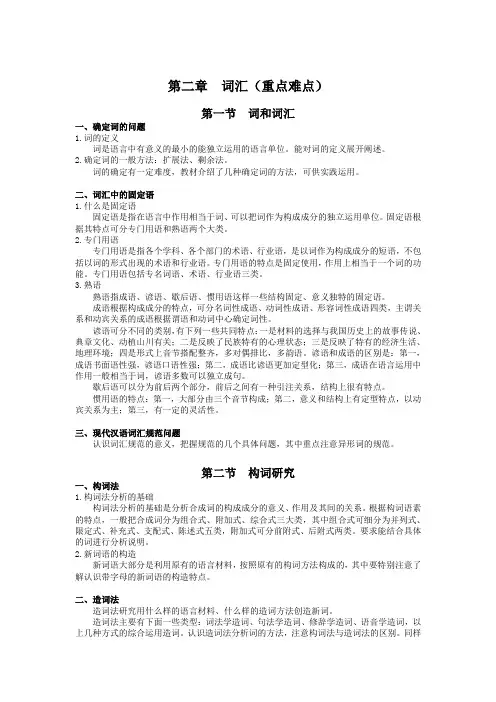
第二章词汇(重点难点)第一节词和词汇一、确定词的问题1.词的定义词是语言中有意义的最小的能独立运用的语言单位。
能对词的定义展开阐述。
2.确定词的一般方法:扩展法、剩余法。
词的确定有一定难度,教材介绍了几种确定词的方法,可供实践运用。
二、词汇中的固定语1.什么是固定语固定语是指在语言中作用相当于词、可以把词作为构成成分的独立运用单位。
固定语根据其特点可分专门用语和熟语两个大类。
2.专门用语专门用语是指各个学科、各个部门的术语、行业语,是以词作为构成成分的短语,不包括以词的形式出现的术语和行业语。
专门用语的特点是固定使用,作用上相当于一个词的功能。
专门用语包括专名词语、术语、行业语三类。
3.熟语熟语指成语、谚语、歇后语、惯用语这样一些结构固定、意义独特的固定语。
成语根据构成成分的特点,可分名词性成语、动词性成语、形容词性成语四类,主谓关系和动宾关系的成语根据谓语和动词中心确定词性。
谚语可分不同的类别,有下列一些共同特点:一是材料的选择与我国历史上的故事传说、典章文化、动植山川有关;二是反映了民族特有的心理状态;三是反映了特有的经济生活、地理环境;四是形式上音节搭配整齐,多对偶排比,多韵语。
谚语和成语的区别是:第一,成语书面语性强,谚语口语性强;第二,成语比谚语更加定型化;第三,成语在语言运用中作用一般相当于词,谚语多数可以独立成句。
歇后语可以分为前后两个部分,前后之间有一种引注关系,结构上很有特点。
惯用语的特点:第一,大部分由三个音节构成;第二,意义和结构上有定型特点,以动宾关系为主;第三,有一定的灵活性。
三、现代汉语词汇规范问题认识词汇规范的意义,把握规范的几个具体问题,其中重点注意异形词的规范。
第二节构词研究一、构词法1.构词法分析的基础构词法分析的基础是分析合成词的构成成分的意义、作用及其间的关系。
根据构词语素的特点,一般把合成词分为组合式、附加式、综合式三大类,其中组合式可细分为并列式、限定式、补充式、支配式、陈述式五类,附加式可分前附式、后附式两类。
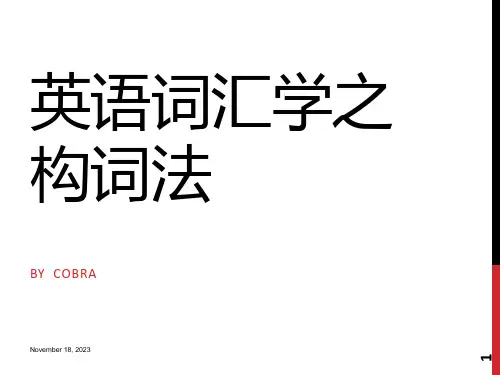
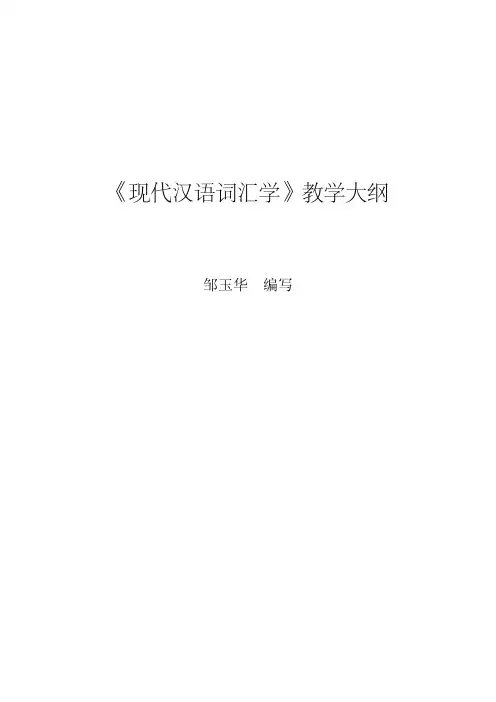
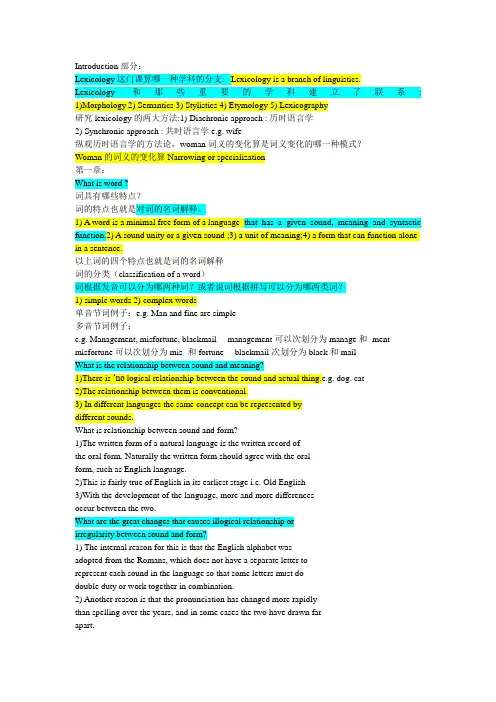
Introduction 部分:Lexicology 这门课算哪一种学科的分支: Lexicology is a branch of linguistics.Lexicology和那些重要的学科建立了联系: 1)Morphology 2) Semantics 3) Stylistics 4) Etymology 5) Lexicography研究lexicology 的两大方法:1) Diachronic approach : 历时语言学2) Synchronic approach : 共时语言学e.g. wife纵观历时语言学的方法论,woman 词义的变化算是词义变化的哪一种模式?Woman 的词义的变化算Narrowing or specialization第一章:What is word ?词具有哪些特点?词的特点也就是对词的名词解释。
1) A word is a minimal free form of a language that has a given sound, meaning and syntactic function.2) A sound unity or a given sound ;3) a unit of meaning;4) a form that can function alone in a sentence.以上词的四个特点也就是词的名词解释词的分类(classification of a word)词根据发音可以分为哪两种词?或者说词根据拼写可以分为哪两类词?1) simple words 2) complex words单音节词例子:e.g. Man and fine are simple多音节词例子:e.g. Management, misfortune, blackmail management 可以次划分为manage 和 -ment misfortune 可以次划分为mis- 和 fortune blackmail 次划分为black 和 mailWhat is the relationship between sound and meaning?1)There is …no logical relationship between the sound and actual thing.e.g. dog. cat2)The relationship between them is conventional.3) In different languages the same concept can be represented bydifferent sounds.What is relationship between sound and form?1)The written form of a natural language is the written record ofthe oral form. Naturally the written form should agree with the oralform, such as English language.2)This is fairly true of English in its earliest stage i.e. Old English3)With the development of the language, more and more differencesoccur between the two.What are the great changes that causes illogical relationship orirregularity between sound and form?1) The internal reason for this is that the English alphabet wasadopted from the Romans, which does not have a separate letter torepresent each sound in the language so that some letters must dodouble duty or work together in combination.2) Another reason is that the pronunciation has changed more rapidlythan spelling over the years, and in some cases the two have drawn farapart.3) A third reason is that some of the differences were created by theearly scribes.4) Finally comes the borrowing, which is an important channel ofenriching the English vocabulary.要记住以上四句话中的关键词:1) influenced by Romans2) Pronunciation changed3) early scribes4) borrowing你能不能举出外来语对英语发音、拼写造成不一致的例子有哪些?e.g. stimulus (L) ,fiesta (Sp) ,eureka (Gr), kimono (Jap)外来语对英语造成的最大的影响就是…sound and form ‟不一致。
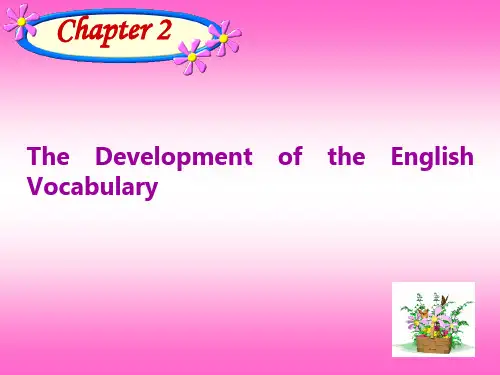
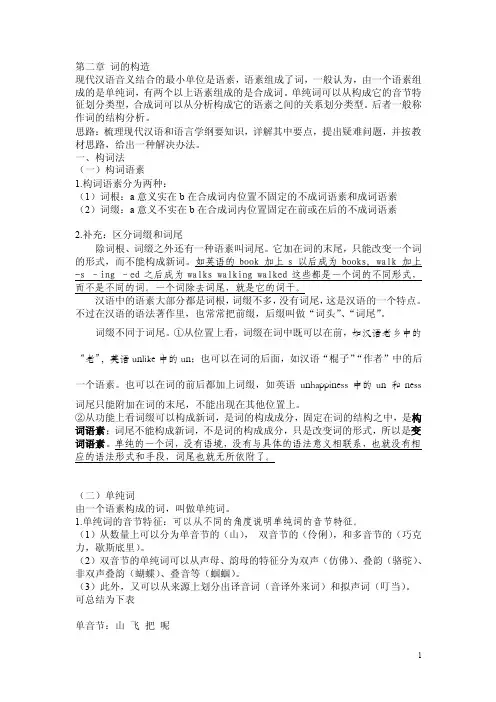
第二章词的构造现代汉语音义结合的最小单位是语素,语素组成了词,一般认为,由一个语素组成的是单纯词,有两个以上语素组成的是合成词。
单纯词可以从构成它的音节特征划分类型,合成词可以从分析构成它的语素之间的关系划分类型。
后者一般称作词的结构分析。
思路:梳理现代汉语和语言学纲要知识,详解其中要点,提出疑难问题,并按教材思路,给出一种解决办法。
一、构词法(一)构词语素1.构词语素分为两种:(1)词根:a意义实在b在合成词内位置不固定的不成词语素和成词语素(2)词缀:a意义不实在b在合成词内位置固定在前或在后的不成词语素2.补充:区分词缀和词尾除词根、词缀之外还有一种语素叫词尾。
它加在词的末尾,只能改变一个词的形式,而不能构成新词。
如英语的book 加上s 以后成为books, walk 加上-s –ing –ed之后成为walks walking walked这些都是一个词的不同形式,而不是不同的词。
一个词除去词尾,就是它的词干。
汉语中的语素大部分都是词根,词缀不多,没有词尾,这是汉语的一个特点。
不过在汉语的语法著作里,也常常把前缀,后缀叫做“词头”、“词尾”。
词缀不同于词尾。
①从位置上看,词缀在词中既可以在前,如汉语老乡中的“老”,英语unlike中的un;也可以在词的后面,如汉语“棍子”“作者”中的后一个语素。
也可以在词的前后都加上词缀,如英语unhappiness中的un 和ness词尾只能附加在词的末尾,不能出现在其他位置上。
②从功能上看词缀可以构成新词,是词的构成成分,固定在词的结构之中,是构词语素;词尾不能构成新词,不是词的构成成分,只是改变词的形式,所以是变词语素。
单纯的一个词,没有语境,没有与具体的语法意义相联系,也就没有相应的语法形式和手段,词尾也就无所依附了。
(二)单纯词由一个语素构成的词,叫做单纯词。
1.单纯词的音节特征:可以从不同的角度说明单纯词的音节特征。
(1)从数量上可以分为单音节的(山),双音节的(伶俐),和多音节的(巧克力,歇斯底里)。
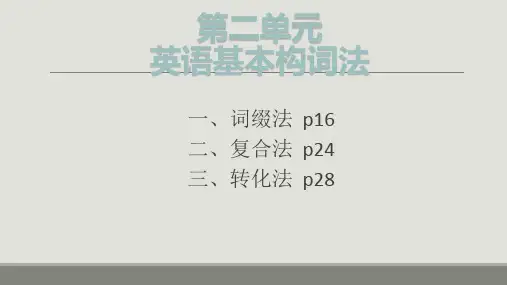
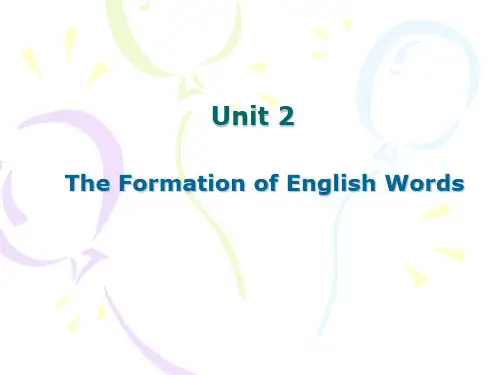
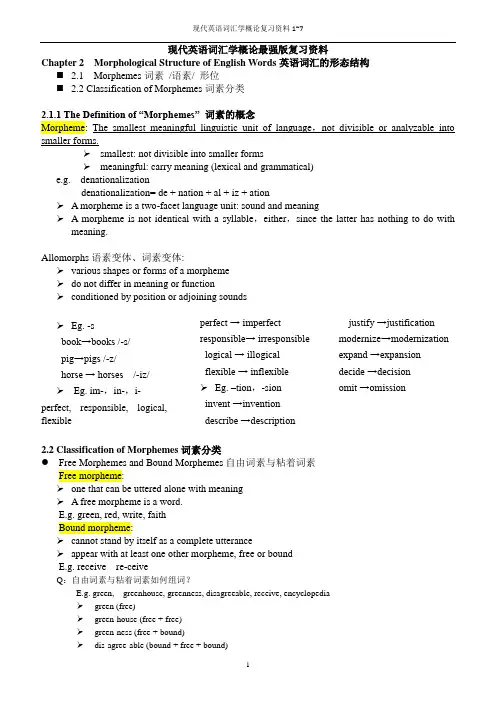
现代英语词汇学概论复习资料1~7现代英语词汇学概论最强版复习资料Chapter 2 Morphological Structure of English Words英语词汇的形态结构⏹ 2.1 Morphemes词素/语素/ 形位⏹ 2.2 Classification of Morphemes词素分类2.1.1 The Definition of “Morphemes” 词素的概念Morpheme: The smallest meaningful linguistic unit of language,not divisible or analyzable into smaller forms.smallest: not divisible into smaller formsmeaningful: carry meaning (lexical and grammatical)e.g. denationalizationdenationalization= de + nation + al + iz + ationA morpheme is a two-facet language unit: sound and meaningA morpheme is not identical with a syllable,either,since the latter has nothing to do withmeaning.Allomorphs语素变体、词素变体:various shapes or forms of a morphemedo not differ in meaning or functionconditioned by position or adjoining soundsEg. -sbook→books /-s/pig→pigs /-z/horse → horses /-iz/Eg. im-,in-,i- perfect, responsible, logical, flexible perfect → imperfectresponsible→ irresponsiblelogical → illogicalflexible → inflexibleEg. –tion,-sioninvent →inventiondescribe →descriptionjustify →justificationmodernize→modernizationexpand →expansiondecide →decisionomit →omission2.2 Classification of Morphemes词素分类●Free Morphemes and Bound Morphemes自由词素与粘着词素Free morpheme:one that can be uttered alone with meaningA free morpheme is a word.E.g. green, red, write, faithBound morpheme:cannot stand by itself as a complete utteranceappear with at least one other morpheme, free or boundE.g. receive re-ceiveQ:自由词素与粘着词素如何组词?E.g. green, greenhouse, greenness, disagreeable, receive, encyclopediagreen (free)green-house (free + free)green-ness (free + bound)re-ceive (bound + bound)en-cyclo-pedia (bound + bound + bound)* A free morpheme is a word.●Roots and Affixes词根与词缀Root 词根: The basic unchangeable part of a word, and it conveys the main lexical meaning of the word.1. Free root (自由词根):A word consist of one free root (or one morpheme)is a simpleword.Free roots provide the English language with a basis for the formation of new words.2. Bound root(粘着词根):roots derived from foreign sources ,esp. from Greek and Latin,belong to the class of bound morphemes, such as tian and cieveEg.1)work, workable, worker, worked, working (free)2) contain, detain, retaintain= tenere (L) = to hold (bound)3) conceive, deceive, receiveceive= capere (L) = to take (bound)4) revive, vitamin, vital, vivacious, vividvit, viv = life / to live (bound)Vital:necessary in order to stay alive-al: pertaining to = have a connection withvital = having a connection with life Vivacious:adj. apprec. full of life and high spirits; lively-ous: full ofvivacous = full of life (energy)Vivid:producing sharp clear pictures in the mind; lifelike-id: having a certain qualityvivid = having a certain quality of lifeAffixes缀: a collective term for the type of formative that can be used when added to another morpheme.1. Inflectional affixes(屈折词缀): serves to express such meanings as plurality, tense, and thecomparative or superlative degree.特点:1.not to form a new word with new lexical meaning2. having only particular grammatical meaning3. only to be affixed to words of the same word-class (not to change the word-class)E.g. Plural marker: pens, oxen, feetGenitive case: Jame’sVerbal endings: works, working, worked, bought, saidComparative and superlative degree: slower, slowest2. Derivational affixes(派生词缀):to be added to another morpheme to derive a new word特点:1. to derive a new word2. having a specific lexical meaning (some also affective meaning)3. some to be attached to words of different word classesEg. Having pejorative or derogatory meaning-ism means“doctrine or point of view ”==socialismPro-means“on the side of ”==pro-com-munist⏹Mini-carmean-nessModern-izeSocial-ism Pro-communist De-codeDe-valueWash-able⏹mis-mal-absorptionpseudo-democratic hire-ling weak-ling child-ish派生词缀分类(derivational morphemes): Prefixes and suffixes1) By linguistic origin:Native affixesForeign affixes2) By productivity:Productive/living affixesUnproductive/dead affixesSummary2.Morphological Structure of EnglishWords英语词汇的形态2.1 Morphemes词素1.The Definition of “Morphemes”词素的概念2. Allomorphs 词素变体2.2 Classification of Morphemes 词素分类1. Free Morphemes and BoundMorphemes自由词素与粘着词素2. Roots and Affixes 词根与词缀free root and bound root自由词根与粘着词根inflectional affixes and derivational affixes屈折词缀与派生词缀。
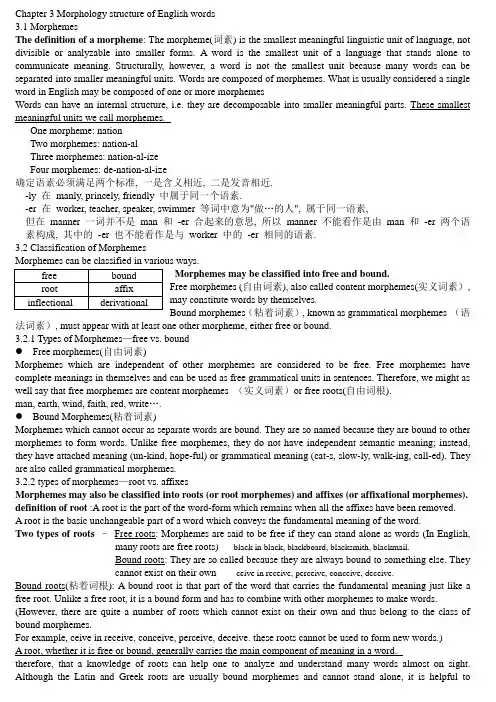
Chapter 3 Morphology structure of English words3.1 MorphemesThe definition of a morpheme : The morpheme(词素) is the smallest meaningful linguistic unit of language, not divisible or analyzable into smaller forms. A word is the smallest unit of a language that stands alone to communicate meaning. Structurally, however, a word is not the smallest unit because many words can be separated into smaller meaningful units. Words are composed of morphemes. What is usually considered a single word in English may be composed of one or more morphemesWords can have an internal structure, i.e. they are decomposable into smaller meaningful parts. These smallest meaningful units we call morphemes.One morpheme: nationTwo morphemes: nation-alThree morphemes: nation-al-izeFour morphemes: de-nation-al-ize确定语素必须满足两个标准, 一是含义相近, 二是发音相近.-ly 在 manly, princely, friendly 中属于同一个语素.-er 在 worker, teacher, speaker, swimmer 等词中意为"做…的人", 属于同一语素,但在 manner 一词并不是 man 和 -er 合起来的意思, 所以 manner 不能看作是由 man 和 -er 两个语素构成, 其中的 -er 也不能看作是与 worker 中的 -er 相同的语素.3.2 Classification of MorphemesMorphemes can be classified in various ways.Morphemes may be classified into free and bound. Free morphemes (自由词素), also called content morphemes(实义词素), may constitute words by themselves. Bound morphemes (粘着词素), known as grammatical morphemes (语法词素), must appear with at least one other morpheme, either free or bound.3.2.1 Types of Morphemes —free vs. bound● Free morphemes(自由词素)Morphemes which are independent of other morphemes are considered to be free. Free morphemes have complete meanings in themselves and can be used as free grammatical units in sentences. Therefore, we might as well say that free morphemes are content morphemes (实义词素)or free roots(自由词根).man, earth, wind, faith, red, write ….● Bound Morphemes(粘着词素)Morphemes which cannot occur as separate words are bound. They are so named because they are bound to other morphemes to form words. Unlike free morphemes, they do not have independent semantic meaning; instead, they have attached meaning (un-kind, hope-ful) or grammatical meaning (cat-s, slow-ly, walk-ing, call-ed). They are also called grammatical morphemes.3.2.2 types of morphemes —root vs. affixesMorphemes may also be classified into roots (or root morphemes) and affixes (or affixational morphemes). definition of root :A root is the part of the word-form which remains when all the affixes have been removed.A root is the basic unchangeable part of a word which conveys the fundamental meaning of the word.Two types of roots – Free roots: Morphemes are said to be free if they can stand alone as words (In English,many roots are free roots) black in black, blackboard, blacksmith, blackmail.Bound roots: They are so called because they are always bound to something else. Theycannot exist on their own ceive in receive, perceive, conceive, deceive. Bound roots(粘着词根): A bound root is that part of the word that carries the fundamental meaning just like a free root. Unlike a free root, it is a bound form and has to combine with other morphemes to make words.(However, there are quite a number of roots which cannot exist on their own and thus belong to the class of bound morphemes.For example, ceive in receive, conceive, perceive, deceive. these roots cannot be used to form new words.) A root, whether it is free or bound, generally carries the main component of meaning in a word.therefore, that a knowledge of roots can help one to analyze and understand many words almost on sight. Although the Latin and Greek roots are usually bound morphemes and cannot stand alone, it is helpful to free boundroot affix inflectional derivationalrecognize some of the common ones, since thousands of English words are built on them. Knowing the meaning of these roots can help clarify the meaning of many English words.3.2.3 Two types of affixesAffixes(词缀): Affixes are forms that are attached to words or word elements to modify meaning or function. According to the functions of affixes, we can put them into two groups: inflectional (曲折词缀)and derivational (派生词缀)affixes.Affixes can be divided into inflectional morphemes and derivational morphemes. This reflects two major morphological (word building) processes:Affix is a collective term for the type of formative (构词成分) that can be used only when added to another morpheme.●Inflectional affixes: does not form a new meaning when it is added to another word. Nor does it change thepart of the word to which it is affixed.●Derivational affixes: when they are added to another morpheme, they derive a new word.Many have a specific lexical meaning. Quite a number of them have more than one meaning. They have affective meaning3.2.3 affixes●Inflectional affixes(曲折词缀)Affixes attached to the end of words to indicate grammatical relationships are inflectional, thus known as inflectional morphemes. For example: cats, walked, walking, John’s book…●Derivational affixes(派生词缀)Affixes added to other morphemes to create new words. They can be further divided into prefixes and suffixes Prefixes(前缀) ; Suffixes(后缀)Inflectional affixes (or inflectional morphemes) serve to express the following meanings:(1) plurality: e.g. -s in chairs, pens; -es in boxes, tomatoes; en in oxen.(2) the genitive case: e.g. ’s in boy’s, children’s.(3) the verbal endings: for example,a. -(e)s in words like eats, teaches shows the third person singular present tense.b. -ing in words like eating, teaching shows the present participle or gerund.c. -(e)d in words like worked, saved shows the past tense or past participle.(4) the comparative and superlative degrees:e.g. -er in words like smaller, harder; -est in words like smallest, hardest.●Derivational Morphemes-- either by changing the meaning of the base to which they are attached; or by changing the grammatical category (part of speech) of the baseDerivational Affixes are subdivided into prefixes and suffixes(1) Prefixes are affixes before the root, e.g. unjust, rewrite.As a rule, most prefixes modify the meaning of roots, but not their parts of speech.task: list some prefixes that can modify the parts of speech. - en-(em-) as in words like embody, enrich (2) Suffixes are affixes after the root, e.g. darkness, worker.By the addition of the suffix, the word is usually changed from one part of speech into another, e.g. liberation, modernizeBoth prefixes and suffixes may be grouped according to:1. Their linguistic origin: Native/foreign affixes1). Native affixes are those that existed in the OE period or were formed from OE words, such as un-, mis-,be-,out-, over-, -ness, -dom, -hood, -ly, and –er.2). Foreign affixes came as a part of loan words from Latin, Greek, French, or other languages. Examples:ab-(L), bi-(L), dis-(L), re-(L), kilo-(Gk), poly-(Gk), mal-(F), -ic(Gk), -ism(Gk), -ist(Gk), -able (F), and –ize(F).A hybrid混合词is a word made up of elements from two or more different languages.2. Their productivity: Affixes (such as re-, un-, -able, -ize) are called productive or living when they can be used to form new words.Those that are no longer used to form new words are termed dead or unproductive.Examples of dead affixes are: for- as in forget, forgive and forbid; with- as in withdraw, withhold and withstand,and –ant or –ent as in servant, different, etc.Sum: Inflection and DerivationDerivational morphemes are used to create new lexical items (lexemes (词位)).Inflectional morphemes only contribute to the inflectional paradigm 词形变化 of the lexemes, which lists all the word-forms of the lexeme.3.2 Types of MorphemesDiagram of morphemesclassification of words on a morphemic levelOn this level, words, according to the number and type of morphemes they contain, can be classified into:(1) simple words: those consisting of a single morpheme, such as man, work, kind;(2) derived words: those which are the result of a derivational process. Such words usually consist of a free morpheme and one (or more than one) bound morpheme, such as fruitless, fruitful, unfruitful, unfruitfulness;(3) compound words: those which are composed of two or more free morphemes, e.g. deep structure, spacesuit, forget-me-not, stick-in-the-mud, and jack of all trades.3.3 Morph and allomorphThe definition of morph(语素形式/词素形式)- phonological (音韵的)and orthographical (拼写的)forms used to represent morphemes. Morphemes can be represented in braces. For example, {big} is pronounced as /big/ and spelled as big, thus /big/ and big are respectively the phonological and orthographical morphs of {big} .Morpheme, Morph, AllomorphA morph is a physical form representing a certain morpheme in a language.Sometimes different morphs may represent the same morpheme; i.e., a morpheme may take different forms. If so, they are called allomorphs of that morpheme.An allomorph(词素变体) is any of the variant forms of a morpheme as conditioned by position or adjoining sounds.区别:语言中最小的不可再分的意义单位是词素morpheme(又可称为形位、语素等)。
词汇学第二章知识点总结第一节语言单位1. 语言单位:词、词组、句子和语法结构词:语言的最小单位词组:由几个词构成的语言单位句子:由词或词组构成的具有完整意义的语言单位语法结构:句子的组织形式,包括层次结构、句子成分、语法关系等2. 词的构成词素:构成词的最小语音和语义单位,可以独立存在或在词中进行构词词根:词的核心,在构词中起着基本作用词缀:附着在词根上,用于构成新词或改变词的词类、意义等词素内部结构:构成词素的内部组合形式3. 词的分类词的词类:名词、动词、形容词、副词、代词、数词、量词和介词词的形式:词的屈折、派生、合成等形式第二节词的意义和词的结构1. 词的意义词义:词语所标示的概念、概括和概念内的发展词语义变化:词义的泛化、特指和引申等变化词的义位:构成词义的回路和成分词的词义关系:近义词、异义词和词义关系2. 词的结构词汇结构:构成词的词素和语音等结构形式词的成分结构:构成复词的内部词结构词语构词法:构成词的词缀、合成等构词手段第三节词义关系和词义演变1. 词义关系上下位关系:词义之间的概括和被概括关系同类词关系:在特定范畴或范围内词义之间的同类关系词语义联系:在使用中词义之间的联系和联系表达2. 词义演变词义的演变:在历史发展和使用中词义的变化和扩展词义变化类型:词义的泛化、转移、借代、内涵、外延等变化类型词义变化因素:历史、社会、文化、语言接触等诸多因素第四节词在句法中的功能和语意1. 词的句法功能词的句法功能:在句中词所承担的成分和功能句法结构:构成句子的各种句法成分的组织形式2. 词的语义特征词的语义特征:词的语义属性和特别意义词的意义转换:词义在句法中的隐喻、比喻、借代和辞让等转换方式词义在句法中的表现:词义在句中所呈现的语义特征和语义表达第五节词汇的心理基础1. 词汇的心理组织词的心理存储:词的存储方式和内部心理结构词汇记忆:词的认知和记忆方式及其规律词的心理连接:词之间在心理中的联结和联系2. 词汇的心理活动词的心理组织:词的认知、思维、理解、表达等心理活动词的心理过程:词的产生、使用、决策、回忆、判断等心理过程第六节词汇习得和使用1. 词汇的习得语言习得:语言学习者获取和掌握词汇的过程词汇习得理论:第一语言习得和第二语言习得的理论及其实践词汇习得策略:词汇习得过程中的学习策略和方法2. 词汇的使用词汇的应用范畴:词汇在语言和交际中的各种应用范畴和方式词汇的使用规律:词汇在使用中的频率、变化、地域差异等规律词汇的使用技巧:词汇使用中的技巧、技能、风格等第七节词汇学的理论和研究方法1. 词汇学的理论词汇研究理论:词汇研究的主流理论和方法词汇学派别:各种词汇学派别对词汇研究的探索和发展词汇发展趋势:未来词汇研究的方向、趋势、发展和应用2. 词汇学的研究方法词汇的研究方法:词汇的描述、分析、解释的研究方法和手段词汇的实证研究:词汇在使用中的实证研究方法和技术词汇的应用研究:词汇在语言学、教育学、心理学等领域的应用研究以上是词汇学第二章的知识点总结。
Unit 21. Word & Morpheme (词素/形位/语素)1) A morpheme is the smallest meaningful unit of a language and the smallest functional unit in the composition of words.词素是语言中语音和语义的最小结合体, 它是语言中最小的构词单位。
2) A word is the smallest unit of spoken or written language which has meaning and can stand alone.词是在口语和书面语中能独立、自由使用的并具备完整意义的语言最小单位。
3) Words are composed of morphemes.e.g.: One morpheme: nationTwo morphemes: nation-alThree morphemes: nation-al-izeFour morphemes: de-nation-al-ize…2.Morpheme, Morph& Allomorph1) Morpheme (词素/形位/语素) : The basic unit of grammatical meaning, an abstract unit of meaning, which cannot be further divided or analyzed.2) Morph 语素形式(形素/形位形式): The unit of grammatical form which realizes a morpheme, the phonological (spoken) or orthographical (written)representation of a morpheme.语素的语音或拼写法的体现。